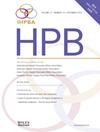一项多中心英国队列研究评估机器人胆总管探查在复杂胆总管结石中的作用。
IF 2.4
3区 医学
Q2 GASTROENTEROLOGY & HEPATOLOGY
引用次数: 0
摘要
背景:对于胆总管结石的金标准治疗尚无共识。这项回顾性多中心队列研究旨在评估机器人胆总管探查(RCBDE)治疗胆总管结石的安全性、有效性和作用。方法:纳入2018年至2024年间所有连续接受RCBDE手术或胆囊切除术后的成人(≥18岁)患者。主要结局是结石清除成功。次要结局包括开放式转换、住院时间、术后并发症和干预措施、30天再入院率和90天死亡率。结果:共进行了102例连续RCBDEs。经胆道通道占86.3%(88/102),经胆道通道占13.7%(14/102)。92.2%(94/102)的病例结石清除,胆漏率为2.9%(3/102),总发病率为19.6%(20/102),其中7.8%(8/102)伴有Clavien-Dindo分级≥3级并发症。总转换率为9.8%,与单独进行RCBDE相比,RCBDE单期手术的转换率明显较低,分别为1.4%(1/73)和30.4% (7/23),(P < 0.001)。结论:RCBDE术后结石清除成功率高,胆漏率低。然而,在既往胆囊切除术后进行RCBDE时,打开转换率显着增加。本文章由计算机程序翻译,如有差异,请以英文原文为准。
A multi-centre, UK-based, cohort study assessing the role of robotic common bile duct exploration for complex choledocholithiasis
Background
There is no consensus on the gold-standard treatment for choledocholithiasis. This retrospective multicentric cohort study aimed to assess the safety, efficacy, and role of robotic common bile duct exploration (RCBDE) in treating choledocholithiasis.
Methods
All adult (≥18 years) consecutive patients undergoing RCBDE either alongside or following cholecystectomy between 2018 and 2024 were included. Primary outcome was success in stone clearance. Secondary outcomes included open conversion, length of hospital stay, post-operative complications and interventions, 30-day re-admission, and 90-day mortality rates.
Results
A total of 102 consecutive RCBDEs were performed. Biliary access was transcholedochal in 86.3 % (88/102) and transcystic in 13.7 % (14/102). Stone clearance was achieved in 92.2 % (94/102) of cases, with a bile leak rate of 2.9 % (3/102), and an overall morbidity rate of 19.6 % (20/102), including 7.8 % (8/102) with Clavien-Dindo grade ≥3 complications. Overall conversion rate was 9.8 %, with significantly lower rates in single-stage procedures, where RCBDE was performed alongside cholecystectomy, compared to RCBDE alone, 1.4 % (1/73) vs 30.4 % (7/23), (P < 0.001), respectively.
Conclusion
This study highlights the high success rate in stone clearance and low bile leak rate associated with RCBDE. However, open conversion rate was significantly increased when RCBDE was performed following previous cholecystectomy.
求助全文
通过发布文献求助,成功后即可免费获取论文全文。
去求助
来源期刊

Hpb
GASTROENTEROLOGY & HEPATOLOGY-SURGERY
CiteScore
5.60
自引率
3.40%
发文量
244
审稿时长
57 days
期刊介绍:
HPB is an international forum for clinical, scientific and educational communication.
Twelve issues a year bring the reader leading articles, expert reviews, original articles, images, editorials, and reader correspondence encompassing all aspects of benign and malignant hepatobiliary disease and its management. HPB features relevant aspects of clinical and translational research and practice.
Specific areas of interest include HPB diseases encountered globally by clinical practitioners in this specialist field of gastrointestinal surgery. The journal addresses the challenges faced in the management of cancer involving the liver, biliary system and pancreas. While surgical oncology represents a large part of HPB practice, submission of manuscripts relating to liver and pancreas transplantation, the treatment of benign conditions such as acute and chronic pancreatitis, and those relating to hepatobiliary infection and inflammation are also welcomed. There will be a focus on developing a multidisciplinary approach to diagnosis and treatment with endoscopic and laparoscopic approaches, radiological interventions and surgical techniques being strongly represented. HPB welcomes submission of manuscripts in all these areas and in scientific focused research that has clear clinical relevance to HPB surgical practice.
HPB aims to help its readers - surgeons, physicians, radiologists and basic scientists - to develop their knowledge and practice. HPB will be of interest to specialists involved in the management of hepatobiliary and pancreatic disease however will also inform those working in related fields.
Abstracted and Indexed in:
MEDLINE®
EMBASE
PubMed
Science Citation Index Expanded
Academic Search (EBSCO)
HPB is owned by the International Hepato-Pancreato-Biliary Association (IHPBA) and is also the official Journal of the American Hepato-Pancreato-Biliary Association (AHPBA), the Asian-Pacific Hepato Pancreatic Biliary Association (A-PHPBA) and the European-African Hepato-Pancreatic Biliary Association (E-AHPBA).
 求助内容:
求助内容: 应助结果提醒方式:
应助结果提醒方式:


